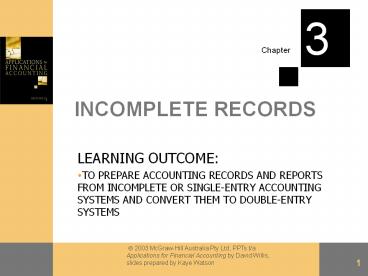INCOMPLETE RECORDS - PowerPoint PPT Presentation
Title:
INCOMPLETE RECORDS
Description:
Insurance companies. Finance or banking organisations. The previous accountant ... Easy to comply with legislative requirements such as GST, income tax and company law ... – PowerPoint PPT presentation
Number of Views:2978
Avg rating:3.0/5.0
Title: INCOMPLETE RECORDS
1
INCOMPLETE RECORDS
3
- LEARNING OUTCOME
- TO PREPARE ACCOUNTING RECORDS AND REPORTS FROM
INCOMPLETE OR SINGLE-ENTRY ACCOUNTING SYSTEMS AND
CONVERT THEM TO DOUBLE-ENTRY SYSTEMS
2
KEY TERMS
- analysis method
- comparison method
- double-entry
- incomplete records
- reconstruction
- single-entry
- statement to ascertain profit
3
REASONS FOR INADEQUATE BUSINESS RECORDS
- Lack of accounting knowledge
- Main concentration on primary activity
- Lack of knowledge on legislative requirements for
accounting record - Hiding cash transactions for tax avoidance
- Confusing business and personal banking
transactions - Lost accounting records e.g. via theft or fire
4
SOURCES OF INFORMATION
- Bank records
- Accounts receivable
- Accounts payable
- Business Activity Statements
- Instalment Activity Statements
- Insurance companies
- Finance or banking organisations
- The previous accountant
5
ADVANTAGES OF DOUBLE-ENTRY ACCOUNTING
- Balancing control (debits credits)
- All transactions are recorded
- Easier to detect fraudulent practices and errors
- Records are kept of business assets
- Liabilities are known
- Profit and loss calculated on regular basis
6
ADVANTAGES OF DOUBLE-ENTRY ACCOUNTING
- Budget comparisons can be made
- Ratios, business trends, sales forecasts and
management information easily determined - Easy to comply with legislative requirements such
as GST, income tax and company law
7
CALCULATING PROFIT AND LOSSES
- THE COMPARISON METHOD
- Used when there is very little business
information available - Many assumptions need to be made
- Comparison is made between the closing Statements
of Financial Position for two financial years to
determine changes in the owners equity during
that period - The comparison is called Statement to Ascertain
Profit
8
STATEMENT TO ASCERTAIN PROFIT
- Use information from two consecutive years to
determine net assets for each year - NET ASSETS OWNERS EQUITY
- Verify net profit using comparison method
Verification of net profit using comparisons of capital Verification of net profit using comparisons of capital
Capital at end 555,000
Less Capital at beginning 500,000
Net change 55,000
Add Drawings 8,000
Less Additional capital 20,000
Net profit 43,000
9
CALCULATING PROFIT AND LOSSES
- THE ANALYSIS METHOD
- Revenue and expense accounting are reconstructed
to obtain missing data - Examples are
- Accounts receivable account to ascertain credit
sales - Accounts payable account to ascertain credit
purchases - Depreciation and accumulated depreciation and
disposal of assets - Balance day adjustments (accruals and prepayments)
10
CALCULATION OF CREDIT SALES
- Illustration 3F (page 63)
11
CALCULATION OF CREDIT PURCHASES
- Illustration 3G (page 64)
12
SUMMARY Analysis method
Statement to ascertain profit
- Accumulated depreciation
- Depreciation
- Closing balance
- Accounts receivable
- Credit sales
- Closing balance
Net profit
Statement of Financial Position
- Accounts payable
- Credit purchases
- Closing balance
- Inventories
- Opening/closing balances
- Closing balance
Opening general journal entry































